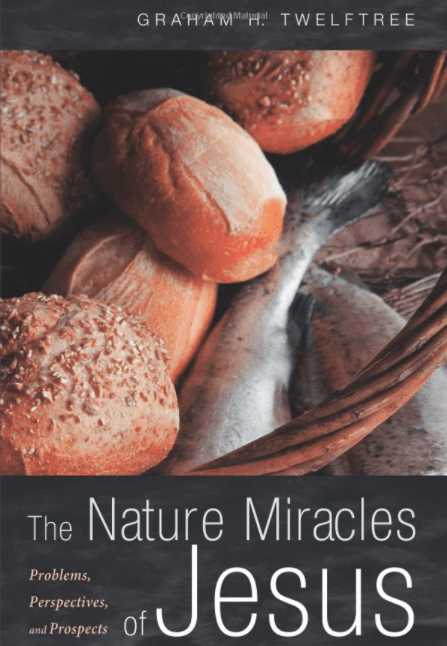 My friend and fellow student of James D.G. Dunn, Graham Twelftree is well known for his robust examination of the miracle stories of Jesus: exorcisms, miracles, etc. Now he has put his hand to editing a book, The Nature Miracles of Jesus: Problems, Perspectives, and Prospects, in which a variety of scholars across the spectrum examine the nature miracles and respond to one another.
My friend and fellow student of James D.G. Dunn, Graham Twelftree is well known for his robust examination of the miracle stories of Jesus: exorcisms, miracles, etc. Now he has put his hand to editing a book, The Nature Miracles of Jesus: Problems, Perspectives, and Prospects, in which a variety of scholars across the spectrum examine the nature miracles and respond to one another.
Graham opens with an admirable but succinct study of how the nature miracles have been understood in church history, and he has special concerns with the skepticism that reshaped this discussion in the modern era.
Every apologist needs this book for it gives immediate access to recent approaches to the nature miracles. Furthermore anyone who cares about the miracles and defending miracles needs to be abreast of this recent research.
Here is Graham’s own summary of the contributions of the authors in this volume:
For most of the history of the discussion of Jesus the nature miracle stories were assumed to have originated in his ministry. The work of Johannes Cocceius in the late seventeenth century, that we noted opened up a fissure between meaning and history, marked a change. With scientific discourse deeply influencing theological enquiry, Jesus researchers increasingly approached the nature miracles in diverse ways, from ignoring them as late entries into the tradition to affirming their essential historicity.
The present project seeks to engage the issues head on. In the next chapter, Craig Keener argues for the historicity of the nature miracle stories associated with Jesus. He argues that while historians may not be able to prove the occurrence of past events they are able to offer credible evidence to support the nature miracles of Jesus. To begin with, Keener points to the otherwise considerable reliable information in the Gospels that portrays Jesus as a miracle worker. Although this does not guarantee the reliability of any one account, it does allow the historian to claim that the nature miracles are consistent with Jesus’ larger ministry. In particular, Keener notes that the category of nature miracle is attested in multiple sources, and that they are both possible and plausible. He concludes that unless historians begin with a prejudice against supernatural activity they lack sufficient reason to question the reports of the nature miracles.
And I agree with Keener’s method and conclusions, while at times I can side with points made by Eve.
Eric Eve explores the possibility that while the nature miracle stories have their roots in actual historical occurrences in the life of Jesus, they have grown in the telling. It is not, he argues in chapter 3, that we need to suppose that a purely natural occurrence was mistaken for a miracle. Rather, a culturally appropriate judgment was made about an event that we would not judge to be miraculous. Eve argues that given that individual and collective memory were shaped to reflect community values and to exalt the founding hero, it is to be expected that stories about Jesus would have grown in the telling. Indeed, he notes there are clear signs that the stories were framed and shaped by Old Testament themes and stories. Yet, it is their partial resistance to such framing and reshaping that lends plausibility to at least some of the stories originating in something that actually took place. However, in that we are unable to reverse engineer the workings of memory or oral tradition, speculative reconstruction produces limited results. Other stories, he judges, may be better explained in terms of myth or invention. Eve concludes that for the Gospel writers the truth about Jesus was not captured in historical truth alone, but also through interpreting him in the light of scriptural precedent and Easter faith.
Keener and his ilk have adequately responded especially to approaches like Crossley’s and Zimmermann’s.
In the fourth chapter, James Crossley argues that we should act as if proving miracles in the traditional historical-critical sense is not part of this game—the historical-critical enterprise. For supernatural activity cannot be established by the historian. Further, what Crossley calls the demise of the “criteria of historicity” shows there is little confidence that the historian is able to prove whether or not miracles “really happened.” Rather, the nature miracles are to be assumed to be pure myth. In turn, these traditions are early additions to the Jesus story. What can be established, and is important, is the belief in miracles, for this would help the historian focus on the ways the first believers constructed identities and developed Christology.
Ruben Zimmermann, in the fifth chapter, offers a literary-hermeneutical approach. On the basis of the distinction in narratology between the discourse and the story he emphasizes that the nature miracle stories associated with Jesus are without any doubt narrated as factual narratives (discourse-level), referring to past events. At the same time, these stories relate something that breaks through any form of “normal” reality, as experienced in daily life (story-level). This aspect shows analogies of these stories with fantasy literature against the definition of fantasy in literary studies. Zimmermann argues that the tension between the factual narrative and the “Active” content of nature miracle stories was already present for the ancient reader, for it is inherent in this kind of text. He concludes that this problem of the nature miracles cannot and should not be “solved.” Instead, he suggests that this tension should be retained, for it drives the hermeneutical process: it reveals that the comprehension and the incomprehension cannot be separated; it provides a sensitivity to God breaking through and transcending norms; and it initiates an enduring process of storytelling for a community.
In the next two chapters, philosophers Michael Levine and Timothy McGrew present opposing views. Both essays take their starting point from Hume’s infamous essay. As his contribution to solving the problem of nature miracles, Levine says that for Hume to frame the question of miracle in terms of laws of nature is neither necessary nor useful. Rather, Levine supposes that the possibility of miracles has more to do with the nature of causation. As an example he focuses on the logical entailment (or logical consequences) theory of causation, showing it to be utterly implausible. The connection between events and causation are not sufficiently loose to allow for miracles. On the other hand, Timothy McGrew shows that the breakdown of Hume’s argument has opened the way for significant developments. He notes Richard Swinburne, among others, arguing that given a high probability of bare theism there is no upper boundary on more specine doctrines, including miracles. Also, brought into view is the mounting number of reports of modern-day miracles. On the last page of his essay McGrew says: “if we have learned any lesson from the collapse of Hume’s everlasting check’ it should be that we have no right to put such claims beyond the reach of evidence.”
Graham summarizes my view accurately. My view is “radical” in the sense that it is maintained all the way to the core. The problem I have with “did Jesus do this or that?” studies is that the result leads to a reconstruction of Jesus, and that reconstructed Jesus is taken to be what we are to believe. The canon and the creed have made that decision. Yes, the historical method yields some probable results; it is especially valuable for apologetics. But for determining what we believe we don’t await the latest conclusions of historians. That is to surrender (our faith) to Caesar. I’m grateful Graham permitted my viewpoint to be part of this book.
Scot McKnight takes a radical approach. He points to the severe limits of what proving the historicity of the nature miracles using historical methods can achieve for the Christian faith, when the Christian faith has already affirmed and assumes such conclusions. For, he notes that this approach uses what he calls an Erastian historiography in which the historian separates and subordinates faith to the historical process and its results. What concerns McKnight is that the historical-critical method produces a limited Jesus that is different from the canonical or creedal Jesus. In turn, echoing Martin Kahler, he says that a Jesus reconstructed by historical methods is an insufficient and uncertain foundation for the church’s faith. McKnight s solution is to propose a “radical separationism.” This, he argues, does not stand in the way of historical enquiry, but also encourages a “plain” reading of the text in order to hear the voice of God and see his power, including in the nature miracles.












